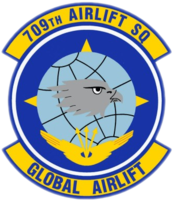709th Airlift Squadron
709th Airlift Squadron
 |
|
|---|---|

A crew from the 709th prepares for a training flight on the first C-5M at Dover Air Force Base
|
|
| Active | 1943–1945 1947–1949 1973–present |
| Country |
|
| Branch |
|
| Size | Airlift |
| Part of | Air Force Reserve Command |
| Garrison/HQ | Dover Air Force Base, Delaware |
| Motto(s) | Global Airlift |
| Engagements | European Theater of World War II |
| Decorations | Air Force Outstanding Unit Award |
| Insignia | |
| 709th Airlift Squadron emblem (approved 29 September 1980) |  |
| 709th Bombardment Squadron emblem (approved 6 September 1943) |  |
| ETO Fuselage Code and Squadron Color |
IE White |
| 447th Bombardment Group tail marking | Square K |
The 709th Airlift Squadron is part of the 512th Airlift Wing at Dover Air Force Base, Delaware.
The squadron was first activated during World War II as the 709th Bombardment Squadron. After training in the United States, it deployed to the European Theater, where it engaged in strategic bombardment missions against Germany. It returned to the United States, where it was inactivated in the fall of 1945.
The squadron was briefly activated in the reserves from 1947 to 1949. In 1973, the squadron was redesignated the 709th Military Airlift Squadron and activated at Dover as a reserve associate unit of the 436th Military Airlift Wing. Its reservists operated the 436th's C-5s alongside members of the regular Air Force.
Since 1973 the squadron has trained for and flown airlift missions with the C-5 Galaxy, It also participates in exercises and global humanitarian and contingency operations.
The squadron was first activated on 1 May 1943 at Ephrata Army Air Base, Washington as the 709th Bombardment Squadron, one of the squadrons of the 447th Bombardment Group.
The original mission of the squadron was to be an operational training unit. However, by the time the 447th group reached full strength in October it had been identified for overseas deployment and its key personnel were assigned to the Army Air Forces School of Applied Tactics at Orlando Army Air Base, Florida for advanced tactical training. The cadre trained at Brooksville Army Air Field with the 1st Bombardment Squadron, engaging in simulated attacks against Mobile, Charleston and New Orleans. The squadron then trained at Rapid City Army Air Base, South Dakota with the 17th Bombardment Training Wing. In June 1943 the group moved to Harvard Army Air Field, Nebraska for Phase I training. The unit sailed on the RMS Queen Elizabeth on 23 November 1943 and arrived at the Firth of Clyde on 29 November 1943. The squadron's B-17s began to move from the United States to the European theater of operations in November 1943.
...
Wikipedia
